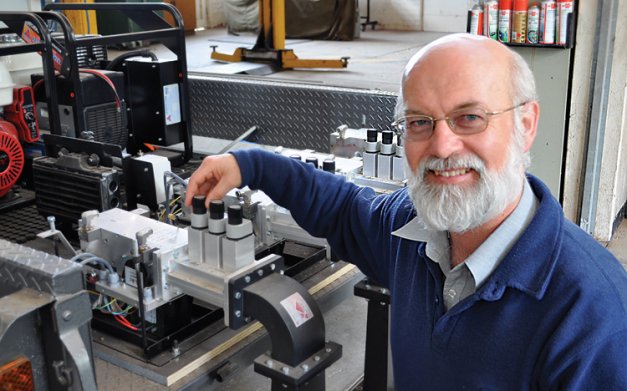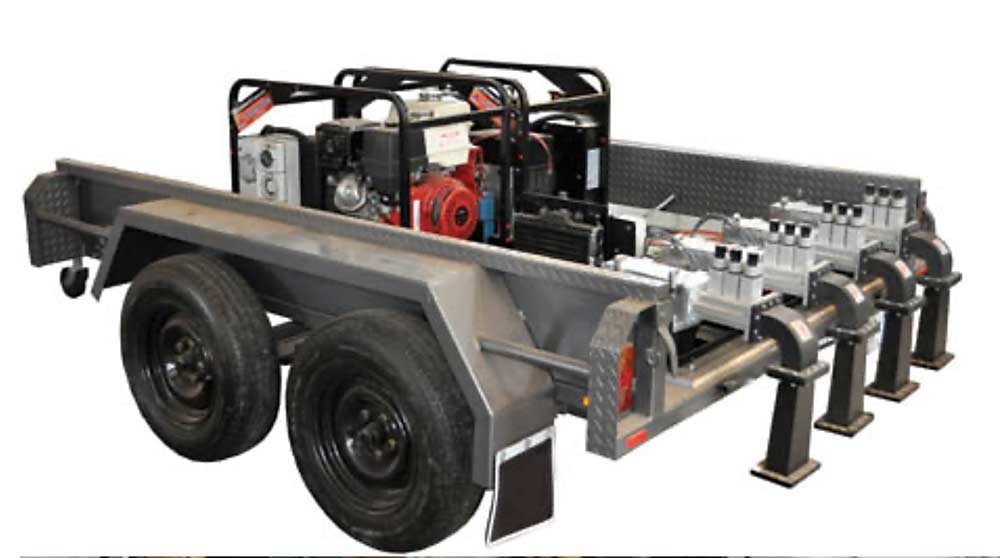
Kitchen microwave ovens are routinely used to “zap” our food. They can heat leftover pizza or cook dinner in minutes. The same technology is being tested in Australia as a chemical-free way to control weeds.
An engineer at the University of Melbourne in Australia has developed an operational prototype weed-killing machine. The prototype, mounted on the back of a tractor, covers a width of 6.5 feet and uses two microwave generators to direct the radio waves at ground level to kill weeds and weed seeds.
Dr. Graham Brodie, who’s behind the weed-killing project, built the system with Australia’s grain growers in mind. “But the system could be adapted to work in orchard and vineyard environments by adding more modules to the system,” he said in an e-mail interview with Good Fruit Grower.
Australian grain farmers have struggled with widespread herbicide resistance and environmental concerns and have limited chemical options for weed management, he said. His research was one of 50 projects that were part of a national weed research and productivity program of the Australian government. The national government provided the equivalent of about U.S.$12.6 million to the Rural Industries Research and Development Corporation to fund projects aimed at improving knowledge of weeds, developing new treatments, and dealing with resistance issues, according to a Rural Industries Corporation news release.

“In looking for alternative weed treatments, we have found that the microwave treatment is immediate, chemical-free, and leaves no residue at the treatment site,” Brodie stated.
When the microwave energy is concentrated and directed to the weeds, the vascular structures within the weeds that carry water collapse. Depending on the amount of energy applied, the technology causes irreversible wilting and subsequent death within seconds of the microwave exposure. “Essentially, emergent plants die of heatstroke and seeds are steamed underground.”
Effect on soil
A key part of the research is learning what effect the microwaves have on soil—soil nutrients, microorganisms, and living things like worms and insects.
Brodie, likening the process to pasteurizing the first couple inches of topsoil, says that studies indicate no significant effect on soil fertility and nutrient value. He has found no effect on the soil’s nutrient value. The microwaves did affect soil bacteria, but the effects were temporary.
“The microwave energy will reduce the number of bacteria in the top few centimeters of the soil,” he said. “However, even very high energy treatments will not destroy all of the bacteria in the soil. We found that bacteria recolonized the soil fairly quickly after the treatment.”
More studies are planned to further investigate the soil biota effects.
“Because it takes much less microwave energy to kill growing weeds compared to the energy needed to kill seeds in the soil, microwave weed management should be achievable with minimal heating in the soil,” he said. “Therefore, I believe it could be possible to kill weeds without affecting tree and vine roots.”
Brodie has not tried the microwave treatment on perennial crops like tree fruit or grapes yet, but he hopes to include such trials as part of his ongoing research project.
Benefits
He believes the microwave technology may have useful application where weeds are resistant to herbicides, where chemical usage is limited, or where weeds have long-lived seeds. It may have potential in organic production. Dosage and speed could be adjusted, depending on whether the target is an emergent weed, which requires less energy than a buried seed.
Brodie says that with the microwave technology, treatment could take place regardless of weather conditions or time of day, and would not limit harvest or production schedules due to preharvest or worker reentry intervals after treatment.
“Microwave weed management has the potential to be applied throughout Australia to manage weeds not just in agricultural enterprises, but on public land, sporting facilities, and in landscape gardening,” he stated. Smaller one- or two-kilowatt units could be designed for household use.
Future research
Brodie sees application of his microwave weed killer both in preplant settings and between plant rows. In the future, he can envision a self-propelled microwave machine guided by GPS that uses infrared technology to turn on the microwave energy only when it encounters weeds.
He initially tested a 600-watt kitchen microwave to kill weeds before developing the 8-kW field unit. For the current 8-kW prototype, the tractor moves at a walking pace.
Further trials are needed to determine if a more powerful 15-kW microwave emitter could operate in the field at or near the current speed of chemical spray applications. “Each seed would then require less than a second of exposure to the microwave transmissions,” he said.
His ongoing research focuses on optimizing the prototype and determining the most efficient microwave energy rate and speed for killing weeds and seeds.
The unit has generated much interest among his country’s farmers. “Preliminary feedback from the Australian agricultural industry indicate that there is genuine market interest in this technology,” he said.
Although Brodie didn’t know what a commercial unit might cost, he hopes to have some commercial models available within the next three to five years. “One of the ongoing studies is evaluating the economic performance and viability of the technology,” he said.
Ultimately, he believes the cost of the technology will be comparable to chemicals, with the main benefit of killing weeds that are resistant to herbicides.

Dear Mrs. Hansen;
I really enjoy to read your report. I am working on control insect by microwave heating. Do you use microwave heating to kill a larvae into tree trunks?
I will be appreciate to answer me.
Thank you in advance
Hassan Sadrnia
Slovenian profesor dr. Matjaz Vidmar developed and tested in cooperation with Università degli studi di Padova, Italia, prototipe of Microvave weed burner in years 2003-2004.